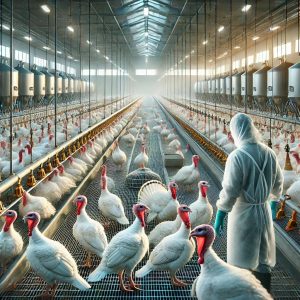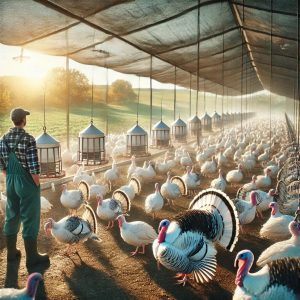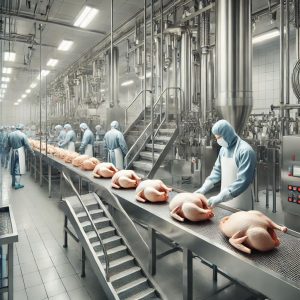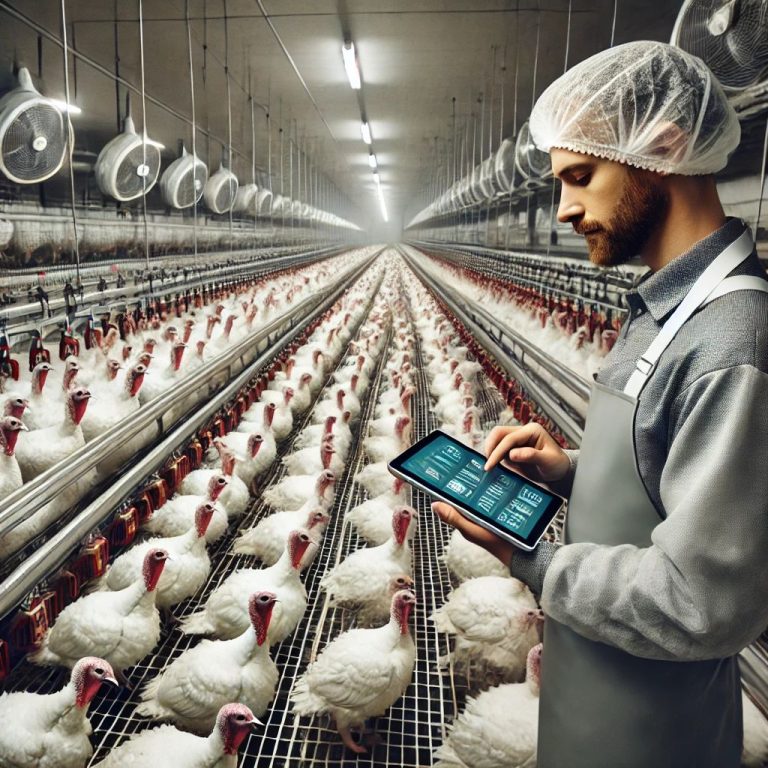Turkey farming is a profitable and rapidly growing sector of the poultry industry, primarily aimed at meat production. Turkeys are valued for their fast growth rate, high feed efficiency, and high-quality lean meat. Whether raised on a small-scale farm or in a large commercial operation, successful turkey farming requires proper management, nutrition, housing, and disease control.
This article provides an in-depth guide to turkey farming for meat production, covering key aspects such as breed selection, feeding programs, housing requirements, health management, and marketing strategies.
Click HERE to join our WhatsApp group
Selecting the Right Turkey Breeds
Choosing the right breed is crucial for achieving high meat yields. The most common turkey breeds for commercial meat production include:
a) Broad Breasted White
The most widely used commercial breed.
Fast growth rate and high meat yield.
White feathers for clean processing.
b) Broad Breasted Bronze
Similar to Broad Breasted White but with darker feathers.
Slightly slower growth but good meat quality.
READ ALSO: Bovine Respiratory Disease: Causes and Management
c) Heritage Breeds (e.g., Bourbon Red, Narragansett, Royal Palm)
Slower growth rates but flavorful meat.
Suitable for free-range or organic farming.
Capable of natural reproduction (unlike Broad Breasted varieties).
Housing and Management

Proper housing ensures optimal growth and minimizes disease risks.
a) Housing Requirements
Provide 1.5 to 2 square feet per poult (young turkey) and 8 to 10 square feet per adult turkey.
Well-ventilated barns to prevent respiratory diseases.
Proper bedding material such as wood shavings or straw.
Adequate protection from predators.
b) Temperature and Lighting
Brooder temperature should be 95°F (35°C) for the first week, reducing by 5°F per week until 70°F.
Provide 24-hour light for the first few weeks, then adjust to 14-16 hours per day to encourage growth.
c) Stocking Density
Avoid overcrowding to prevent aggression and stress.
Maintain 10-12 turkeys per 100 square feet.
Feeding and Nutrition
A well-balanced diet ensures proper growth and high meat yield.
a) Nutritional Requirements
Turkeys require different feed formulations at different growth stages:
Growth Stage Protein (%) Feed Type
Starter (0-6 weeks) 28% High-protein crumbles
Grower (6-12 weeks) 22-24% Pelleted feed
Finisher (12+ weeks) 18-20% Lower protein feed to improve meat quality
b) Feeding Schedule
Provide constant access to fresh, clean water.
Use automatic feeders for large flocks to reduce feed wastage.
Include grit in the diet for proper digestion.
READ ALSO: Beef Cattle Farming: Breeds, Housing, and Management
c) Supplements and Additives
Probiotics and prebiotics to improve gut health.
Calcium and phosphorus for strong bones.
Vitamin supplements to enhance immunity.
Health Management and Disease Control
Preventative health care is crucial in turkey farming.
a) Common Turkey Diseases
Fowl Cholera – Bacterial infection causing swollen joints and respiratory distress.
Blackhead Disease – A protozoan infection affecting the liver and intestines.
Newcastle Disease – Viral disease leading to respiratory and neurological issues.
Coccidiosis – Parasitic infection causing diarrhea and weight loss.
b) Prevention and Control Measures
Maintain strict biosecurity measures to prevent disease introduction.
Regular vaccination programs for common poultry diseases.
Provide clean drinking water and well-ventilated housing.
Use medicated feeds or natural alternatives like oregano oil to reduce disease risk.
Growth Performance and Weight Management

Monitoring growth rates ensures optimal meat production.
a) Expected Growth Rates
Age (Weeks) Expected Weight (lbs)
4 3-5
8 7-10
12 14-18
16 22-30
20 35-50
b) Factors Affecting Growth
Genetics – Breed selection affects growth rate.
Feed Quality – Poor nutrition leads to slower growth.
Environmental Conditions – Stress and temperature fluctuations impact weight gain.
Processing and Marketing

Processing and marketing strategies determine profitability.
a) Slaughter and Processing
Turkeys are typically slaughtered between 16-22 weeks of age.
Humane slaughtering methods should be used for ethical processing.
Chilling and proper storage maintain meat quality.
b) Marketing Strategies
Wholesale Supply – Sell directly to supermarkets and processors.
Farm-to-Table Sales – Sell fresh turkeys to local consumers.
Value Addition – Process into smoked turkey, turkey sausages, or frozen cuts.
Organic and Free-Range Branding – Target health-conscious consumers.
Economic Viability and Profitability
Turkey farming can be highly profitable with proper management.
a) Cost Analysis
Initial investment includes housing, equipment, and chicks.
Major operational costs include feed, labor, and health management.
Returns depend on market prices and production efficiency.
b) Strategies for Profit Maximization
Reduce feed costs by using locally available grains.
Adopt efficient breeding programs for high meat yield.
Diversify products by offering processed and specialty turkey meat.
Conclusion
Turkey farming for meat production presents a lucrative opportunity for farmers willing to invest in proper management, nutrition, and biosecurity. Selecting the right breed, providing balanced nutrition, ensuring optimal housing conditions, and implementing strong disease prevention measures are key to success. With strategic marketing and efficient cost management, turkey farming can yield high returns and contribute significantly to the poultry industry.
READ ALSO: Calcium and Other Nutrients for Egg-Laying Hens
Egg production is a nutrient-intensive process that requires a well-balanced diet to ensure optimal hen health and productivity. Among the various nutrients needed, calcium plays a critical role in eggshell formation, bone health, and overall well-being of laying hens. However, calcium alone is not sufficient—other essential nutrients, including proteins, vitamins, and minerals, must also be supplied to maintain peak egg production and prevent health complications…
READ ALSO: Energy Sources in Poultry Diets
Energy is one of the most critical components in poultry nutrition, influencing growth, reproduction, egg production, and overall performance. Poultry require energy to sustain bodily functions, maintain body temperature, and perform activities such as feeding, walking, and laying eggs. The primary sources of energy in poultry diets are carbohydrates, fats, and, to a lesser extent, proteins…
Click HERE to join our WhatsApp group

